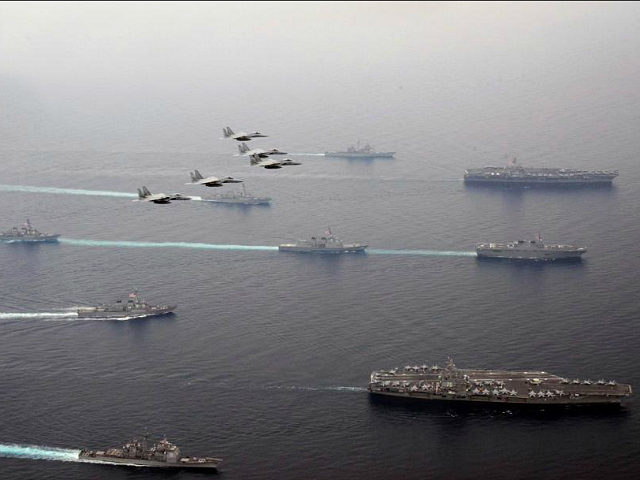A joint military exercise between the United States and Japan began in the Sea of Japan on Thursday amid tensions caused by North Korean missile launches and a possible upcoming nuclear test.
“Japan’s Maritime Self Defence Force has sent two ships, including one of its four helicopter carriers, the Hyuga, to join the U.S carriers, the USS Ronald Reagan and USS Carl Vinson, and their eight escort ships,” according to a Japanese military statement quoted by Reuters. F-15 fighters from Japan’s Air Self-Defense Force will simulate combat with U.S. Navy F-18s.
A Japanese military spokesman noted that it was Japan’s first exercise with multiple U.S. carriers.
Asahi Shimbun called the exercise a “massive show of force” intended to “show the partnership between Japan and the United States at a time when North Korea is continuing to take provocative actions, including ballistic missile tests.”
A senior Japanese Defense Ministry official described the joint American-Japanese fleet as “utterly invincible” and told Japan News that North Korea will “likely be feeling the pressure” after watching its exercises.
Japan News notes the fleet could target North Korea with about 300 Tomahawk missiles, in addition to mustering 150 top-of-the-line fighters from the carriers and bases in South Korea and Japan, plus strategic bombers flying out of the U.S. base on Guam. Impressive as that sounds, former Japanese Self-Defense Forces commander Yoji Koda said it was well short of the 1,000 Tomahawks that would be needed to “temporarily neutralize North Korea’s underground bases in an initial attack.”
“As long as there is a risk of casualties in a counterstrike, it’s impossible to imagine that the United States would launch a preemptive strike,” he pointed out.
Nikkei Asian Review sees U.S.-North Korea tensions “inching toward the breaking point,” speculating that North Korea’s most recent missile launch was meant as a warning shot against American carriers.
Despite these alarming observations, analysts told CNN they expected the current North Korea crisis to end much as previous confrontations have. “North Korea will call our bluff, the US will draw back from using military force, and North Korea will continue to develop their nuclear program,” as Professor Robert Ross of Boston College put it.
The most alarming possibility for an alternative to the same old ending was supplied by Dean Cheng of the Heritage Foundation, who speculated that North Korea might consider attacking South Korea with conventional weapons if they “think they can get away with it” because they have developed nuclear ICBMs.
“This is a regime that’s done a lot of things that are pretty out there and when you look at all of that one can’t be sure what they would do if they had nuclear capable ballistic missiles,” said Cheng.

COMMENTS
Please let us know if you're having issues with commenting.